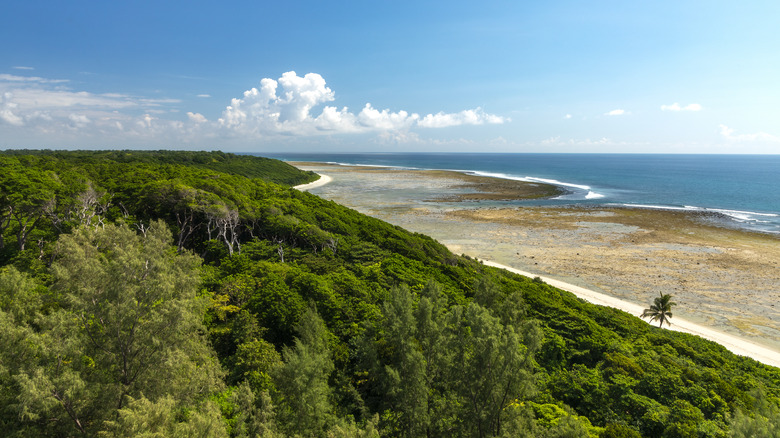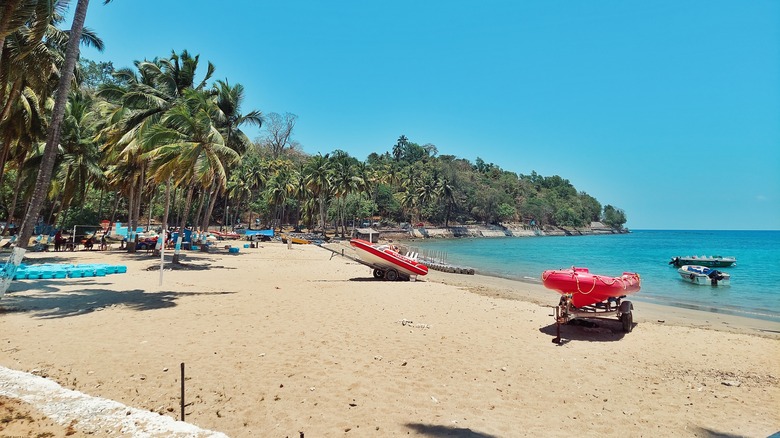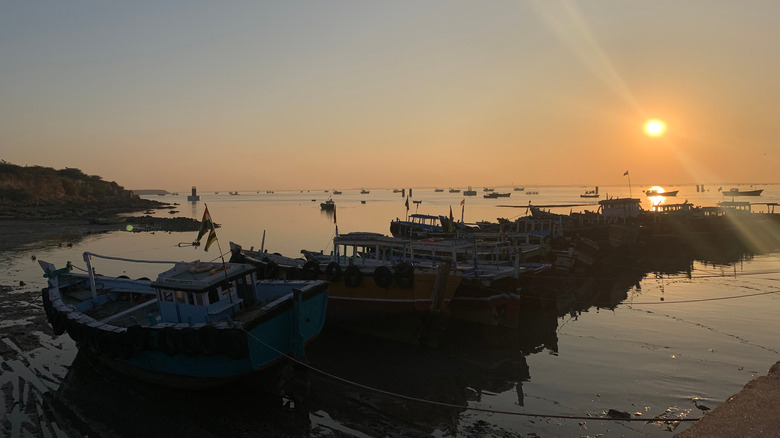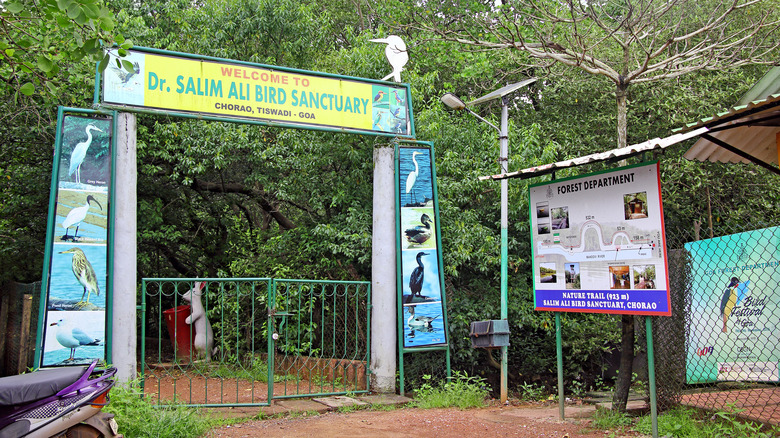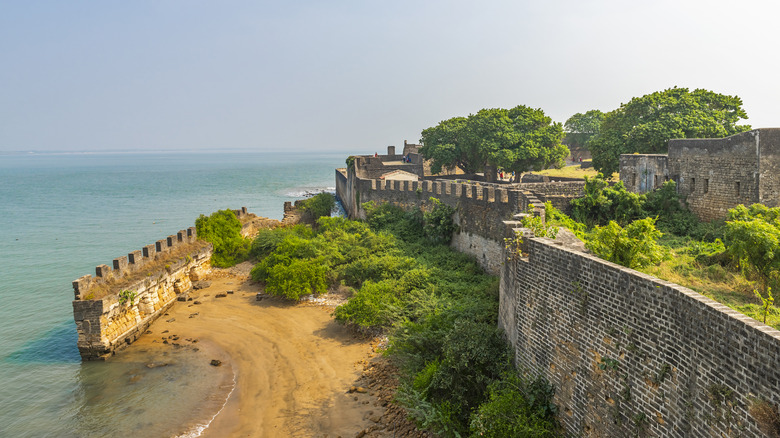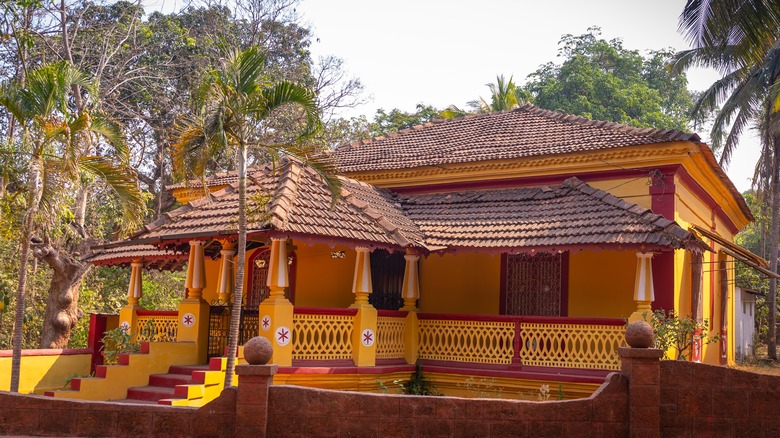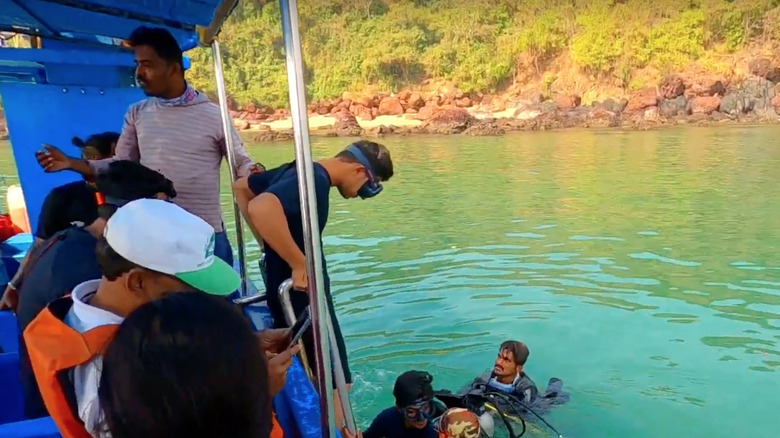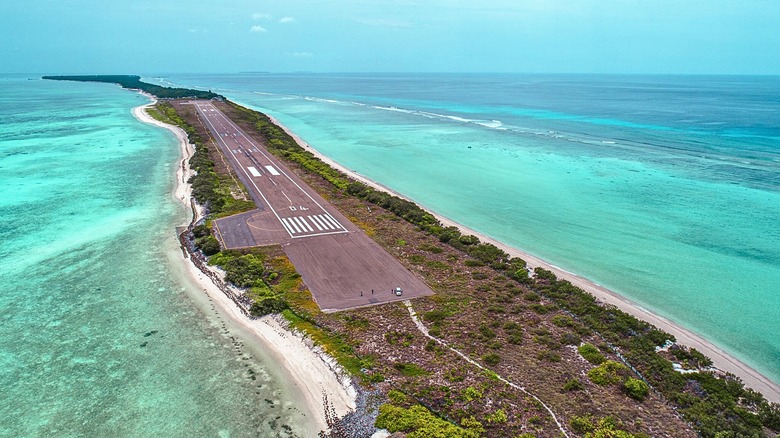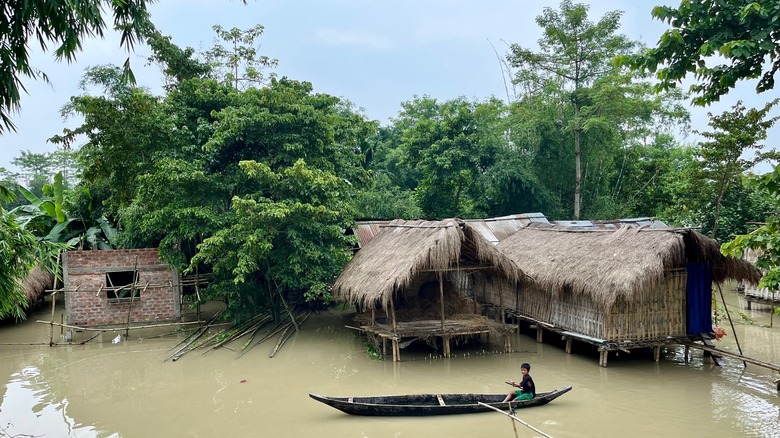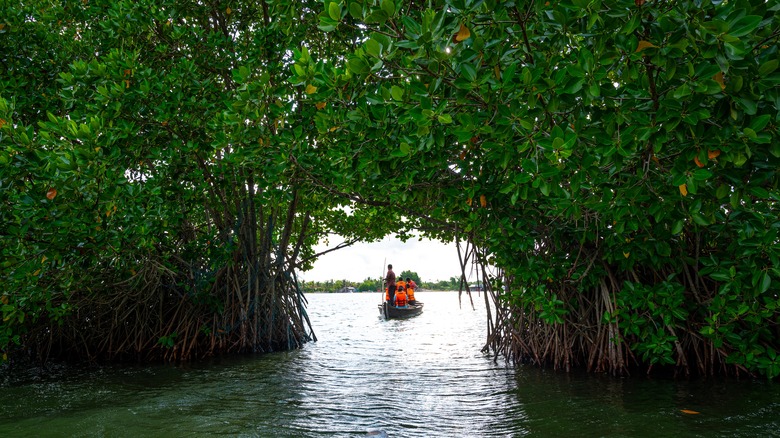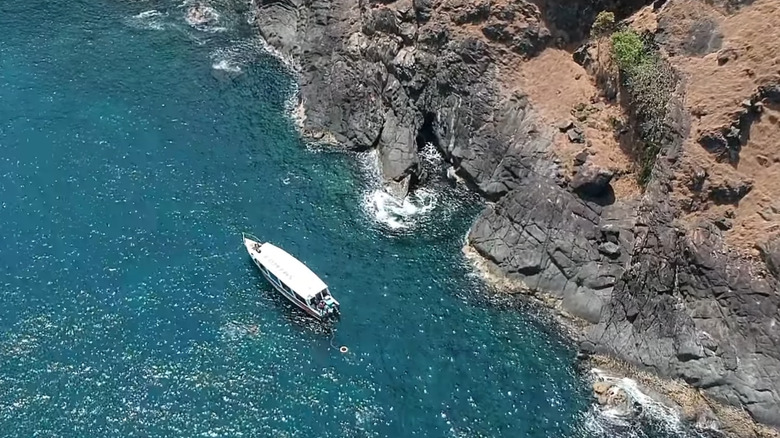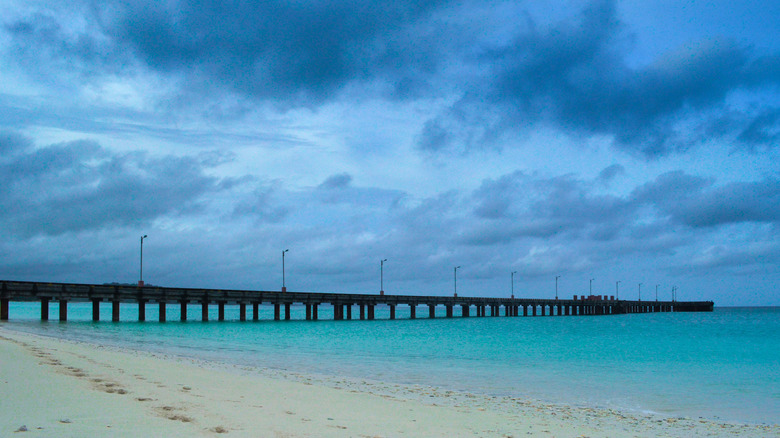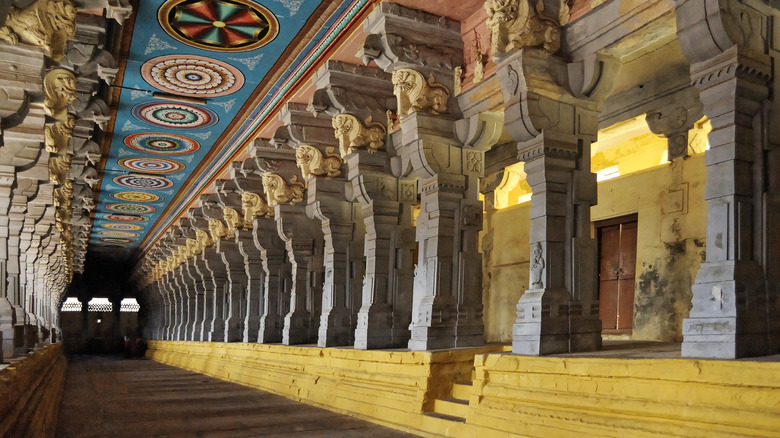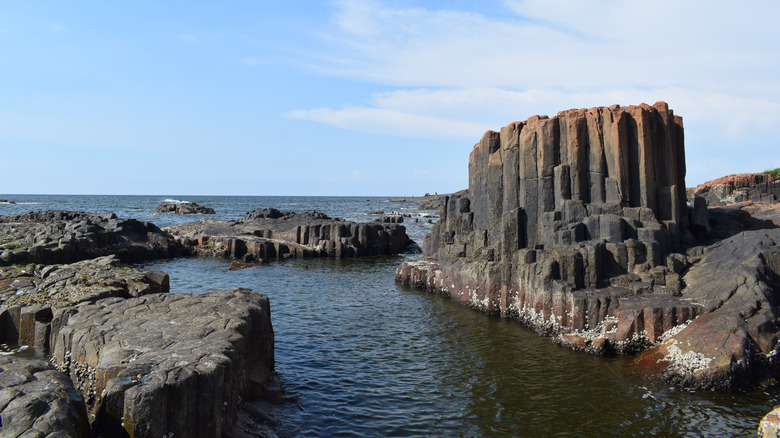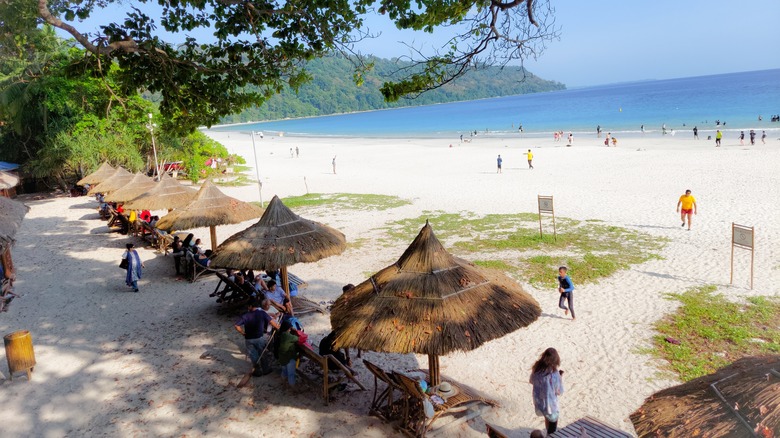The Most Picturesque Islands In India To Add To Your Bucket List, According To Travelers
The world's most populous nation is a place of sights and sounds unlike any other. This is where you can experience global icons like the Taj Mahal (check out the important details you should know before visiting the Taj Mahal). You could also just wander around and admire its many gems — the nation is the birthplace of four religions, so there is much to explore. India has a vast geographical range, shaped vaguely like a diamond, with water on many sides and the Himalayas at the north. There's no shortage of things to do and see in India, but stories about the country tend to focus on the cities or the fabled architecture.
What's often missing is information on the country's islands. India is actually home to more than 1,000 islands, from those close to cities to those moored in the middle of the ocean. The city of Mumbai, in fact, was originally seven islands, but it has since joined up to create a place that is India's financial powerhouse. Looking at blogs and reviews, we've put together some of the country's most striking islands; these are destinations you should consider as bucket list ideas for travel.
Andaman Islands
Looking at a map, travelers might be surprised that these islands are part of India. An archipelago that unravels in a north-south direction across the Andaman Sea, they are closer to the west coast of Thailand than they are to India. This grouping of tropical islands promises visitors gorgeous blue seas all around, though the various islands in the chain have their own selling points. Barren Island is the only verified active volcano in India, and though visitors can't step on the island, boats can tour around it. It's a craggy, mountainous spot that scores highly on Tripadvisor; it last erupted in 2005.
Swaraj Dweep, formerly known as Havelock Island, has fine strips of sand, calm, clear seas, and coral reefs that are great for snorkeling — even if this is not one of the world's best islands for snorkeling, it's worth seeing. Close by, Neil Island has a laid-back vibe and features equally appealing swimming and sea life. The island is small enough to get around on a bicycle. Near the capital of the Andamans, Port Blair, Netaji Subhash Chandra Bose Island is filled with history. It's a tiny island, smaller than a square mile, and was turned into a prisoner of war camp by the Japanese during World War II. Visitors can see an old church and a graveyard where the British were buried.
Beyt Dwarka
This island is shaped vaguely like a seahorse and is located at the edge of the Gulf of Kutch, where it meets the Arabian Sea. It has a fascinating cultural destination, and travelers will find winding alleys and lots of temples on an isle where a Hindu god once lived. Beyt Dwarka is where Lord Krishna, a Hindu deity, is believed to have established a home. Today, visitors will find shrines dedicated to him, as well as some for other gods — Hanuman, Shiva, Vishnu, and more. The island is connected to the mainland by the Sudarshan Setu cable bridge, the longest in the country, officially commemorated in February 2024.
The temples on Beyt Dwarka are colorful and widely visited. They consist of bright statues and ornate stonework. On the coast, tourists will find tranquil beaches and the opportunity to go diving. For visitors looking to experience the island when it is ripe with celebration, come during Janmashtami, which celebrates the birth of Krishna and takes place in August.
Chorao Island
A popular beach destination in India, Goa is the smallest state in the country. Think of islands in Goa, and you might imagine one sitting offshore, ringed by glittering seas. But Chorao Island is actually set within the Mandovi River and is an oasis of nature and greenery. As a visitor noted on Tripadvisor, "The lush green nature during monsoons is a sight to behold on Chorao Island." What makes the island all the more remarkable is that it's only a few miles away from Panaji, the capital of Goa, and a hotbed of restaurants, cafés, bars, nightlife, and tourists.
Where Panaji is all commerce and cacophony, Chorao is verdant and serene. This is where to find Salim Ali Bird Sanctuary, where herons, kingfishers, and many migratory birds live among the mangroves and water channels in and around the island. You can also visit old churches, which have Portuguese influences and pretty façades. Foodies will want to make stops in the small villages around Chorao to sample some Goan dishes in simple, low-key restaurants.
Diu Island
This island sits at the southern tip of Gujarat state, some distance northwest across the Arabian Sea from the heaving metropolis of Mumbai. Travelers to Diu will find a destination with great culture, history, and beaches. One of the foremost attractions is St. Paul Church, sometimes identified as the Church of Immaculate Conception. A vision in white, it was started in 1601 and was built by the Portuguese in Gothic style, with work finishing in 1610. Visitors can marvel at the vaulted dome, recurring shell motifs, and austere, black wood altars.
Panikotha is a commanding fortress that sits out in the sea, just off the coast of Diu. It was built in the 1500s to protect merchant ships, especially those carrying spices from India. This is a unique sight, a bastion surrounded by water, and at night, when lit, the effect is quite special. Also, on Diu, visitors can take in a museum that delves into the regional history, a bird sanctuary with scores of pink flamingos, and a pair of beaches where jet skis and other water sports are available.
Divar Island
Sitting next to Chorao Island, Divar is another easy escape close to the capital of Goa, Panaji. Old villages and verdant rice paddies give this island in the Mandovi River a distant feel, even though it's near the state's main hub. There are sites that should definitely be part of a visit. The Kadamba Dynasty ruins are set on top of a hill and feature a church built on the site of a former Hindu temple that was destroyed by Muslim soldiers. Look for carvings in the church that date back centuries. The Museum of Christian Art presents a deep dive into the work of Goa's Christians. Guests will be able to pore over silverware, paintings, and furnishings that showcase influences from Portugal and India.
From the Church of Our Lady of Compassion, the dome and bell tower are pleasing to the eye, while the views of the river and over Diu are memorable. Other pleasures include wandering around small villages and seeing bright green rice paddies and old Portuguese-style homes around the island. There's also plenty of animal life here, as a commenter on Tripadvisor noted. "We spent [three] days on Divar Island and enjoyed the peace and quiet roads. There are some very nice houses on the island, but we were there mainly for the birds and the wildlife, and we weren't disappointed."
Grand Island
Also known as Ilha Grande or Bat Island, this refuge sits only a few miles away from Goa's main international airport. It's a good destination for water sports, snorkeling, and the exciting excursion of dolphin spotting. Visitors generally come to the island on scheduled boat tours with local operators, and trips tend to be in the calmer months outside monsoon, so October through April or May. Trips are most easily done from Vasco da Gama, the city less than a mile from the island. From offshore, you'll be able to see the rocky shoreline, with coves and inlets that act as safe harbors for fishermen during unpredictable weather.
There are no places to stay overnight on the island, as it is actually owned by the Indian Navy, but visitors can still find much to enjoy. One beach that draws many a day tripper is Monkey Beach, while Suzy's Wreck is a well-known dive site off the coast. En route to the island, tourists might also see Goa Jail and Fort Aguada.
Lakshadweep Islands
This grouping of islands spreads across the Indian Ocean. The archipelago's name means "hundred thousand islands," though in reality, there are only 36 of them. They all sit west of India, though Minicoy, for instance, is closer to the islands of the Maldives than to the country. What they all promise, however, is lovely turquoise water, making them an Indian alternative to the Maldives, a destination with kid-friendly resorts for the perfect family vacation and the best resorts for food lovers.
Lakshadweep consists of 12 atolls and 3 reef systems, and of all the isles, only 10 have human populations on them. Warm, sunny, and seductively tropical all year round, the isles are best visited from October through March, when rainfall is minimal. April and May tend to be hot and very humid, while the summer months are when monsoon hits.
Agatti Island is long and skinny and is home to the main airport. Its shimmering lagoon invites travelers who love to swim in the sea. There are more beaches and clear seas throughout the archipelago. Narrow Kadmat Island has lagoons on either side, some shallow enough that they are perfect for visitors with limited experience swimming in open water. As one commentator on Tripadvisor wrote, "This is the most beautiful small island in the world." For a real escape, go to Minicoy. It lies more than 100 miles from the other islands and features small villages and a lighthouse built by the British that's about 300 feet.
Majuli Island
In the east of India, in the strip of land where the country reaches out toward China, this huge river island is an advert for the simple life. As a reviewer on Google puts it, "A place of serene natural beauty, a calm, quiet, and peaceful place in a true sense. House of rich and diverse religious and cultural heritage, indigenous community living, and lifestyle. [It is a] favorite place for migratory birds in winter. [The] food of the people of Majuli is a must-try. A wonderful place to enjoy pristine sunrise and sunset." Majuli island sits within the Brahmaputra River, a deeply revered waterway for a number of religions in India.
There are a couple of main hubs on the island, such as the settlements of Garamur and Kamalabari, but the rest of the island is characterized by small villages, tracts of forest, and plenty of wildlife. The island feels like it belongs to a different era, tranquil and dated, with some residents living in unfussy bamboo huts, with the relentless drive of urban life a million miles away. There are monasteries around Majuli, and birders will enjoy the chance to spot egrets, purple moorhens, and storks, among other avian life.
Munroe Island
This destination in Kerala occupies the liminal space between rivers and lakes and is a great spot to go boating. Though the name suggests one solitary island, Munroe is actually a conurbation of eight different isles, with slender channels and skinny lakes slicing between them. The island's name comes from a former administrator, John Munroe, who masterminded the creation of canals in the interior of Kerala. These canals have helped to bolster the image of Kerala's backwaters, a web of waterways flanked by verdant land.
On a boat, you can glide along tranquil waterways, wind through thickets of mangroves, and watch villagers cross over bridges that span the channels. One of the highlights of any boat tour is a naturally formed arch of mangroves, through which sunrise and sunset can be seen when on the water. Other sights not to miss are the bungalow of John Munroe, where photos trace the owner's past, and a Dutch church dating from the 1800s.
Netrani Island
Shaped a little like a heart, this island floats in the waters off the coast of Karnataka state. It's a rocky spot with no facilities and a beach on its northern side, but what makes it hugely appealing is the opportunity to explore the waters off its coast. As a visitor posted on Google, Netrani has "Clean and clear water ... corals, and ... [several] types of fishes! All over, its a best place for snorkeling and also for scuba diving!"
Access to the island is typically via boat from Murudeshwara, a town on the Karnataka coast known for its temples. Visitors can certainly step onto the island, where they'll find clumps of trees and crags of rock where pigeons huddle, but the real joy is in the sea. The conditions mean that the snorkeling and diving here are suitable for both newbies and seasoned seafarers. In the water, divers will find lots of fish and intriguing corals on display. With its instructors and attendants, Netrani Island might seem like a beginner's guide to scuba diving like a professional.
Nicobar Islands
These islands are usually referred to as part of the Andaman and Nicobar Islands, and they are technically part of the same territory in India. But the Nicobar Islands sit some distance south of the Andaman Islands, and the southernmost of them are actually less than 100 miles from the coast of northern Sumatra, in Indonesia. There are a handful of islands in the Nicobar chain, and some were used as penal colonies by the British in the Second World War. The Japanese also occupied the islands during that war.
Visitors will notice the differences among the Nicobar Islands. Car Nicobar is relatively level, with soil that allows for small-scale agriculture, whereas the other islands are much more vertical, with Mount Thullier on Great Nicobar climbing up to 2,100 feet above sea level. Forests blanket all the islands; looking up, travelers might spot mangoes growing on trees and palm and pandanus leaves swaying in the breeze. Tourists might also spot the endemic Nicobar red-tailed macaque if they can ever avert their gaze from the fine beaches and crystal clear waters. Two tribes live on the islands, one deep in the forests with minimal contact with outsiders.
Rameswaram Island
Also known as Pamban Island, this isle sits between India and Sri Lanka, a visual bridge of sorts between the two nations. It's a place of great spiritual effervescence, with temples dotted around the island, and devotees regularly making pilgrimages to offer up prayers. The most famous among the shrines might be the Ramanathaswamy Temple, with its gleaming gold tower, brightly colored corridors with ornately carved pillars, and a grand sense of occasion.
Stories from Hindu scriptures are linked to this part of the country, which accounts for the high regard in which it's held. But religion isn't the only draw to this small isle. Travelers can find quiet beaches, old historic ruins, a point where flamingoes congregate, and options for taking a boat out in the sea. Snorkelers might enjoy an excursion to Krusadai Island, just offshore — it has fine beaches, calm seas with vibrant reefs, and waters where turtles roam.
St. Mary's Islands
Lying off the coast of Karnataka, near the towns of Malpe and Udupi, these islands have jagged, irregular coastlines. The islands are all uninhabited, making them a dream destination for a traveler wanting to get away from it all. The largest of them, which sits in the north, is St. Mary's Island, where pretty basaltic rocks give the shoreline a dramatic heft. The rock here is similar to that found in Madagascar, off the coast of Africa, and one theory posits that the two landmasses were once linked. Apart from the rocks, some of which appear like columns clumped together and rising from the sea, there are beaches to enjoy and calm waters to slide into.
One beach on St. Mary's Island is filled with shells, hence its name, Shell Beach. On another island in the cluster to the south, the Daria Bahadurgad Fort is a trip back in time, a complex of ruins that testify to the history of the region and from where the sunset views are memorable. The best time for a visit is from October through January when the sea is calm and the weather isn't sweltering. During monsoon, from June to September, boat crossings become dangerous, and the island closes down for travelers. On the boat ride over to these islands, visitors might see Brahminy kites soaring across the sky or dolphins spinning in the sea.
Methodology
Of the 1,000-plus isles in and around India, there are so many worth visiting. But time is finite, and winnowing down a list of those really worth the effort was no easy task. We looked at travel blogs like Trippyigloo, Holidify, and Travel.Earth to find island gems. Getting first-hand plaudits was also important, so we checked out reviews on Google and Tripadvisor to make sure the picks were places worth pulling out all the stops for. We also ensured to select islands in various parts of the country so that on your next trip to India, getting to one of them wouldn't be a logistical challenge.
